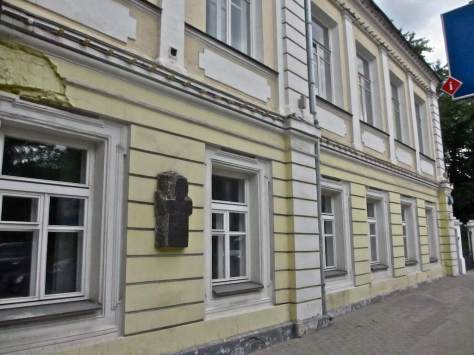I’ve been hanging around the same basic place in Moscow this week. The Yermolova House, which I wrote about a couple of days ago, is a few doors down from the home we’re talking about today at 25 Tverskoi Boulevard. Yesterday I wrote about the Alexander Herzen statute which stands right next to it, because Herzen was born here. Today we’re interested in the house because the great poet Osip Mandelshtam lived here in 1922 to 1923 and then again from 1932 to 1933. This was quite a place actually. Aside from the Herzen connection, and the fact that Mandelshtam and Andrei Platonov lived here (I’ll write about Platonov soon), this was the site of a popular literary salon hosted in the 1840s and 1850s by the Russian diplomat and memoirist Dmitry Sverbeev. The so-called Sverbeev Fridays were frequented by Herzen, philosopher Pyotr Chaadayev, poets Nikolai Ogaryov and Yevgeny Baratynsky, and prose writers Konstantin Aksakov and Nikolai Gogol. The literary critic Dmitry Blagoi lived here, as did, more briefly, the writers Mikhail Prishvin, Vsevolod Ivanov and Boris Pasternak. Russia’s primary literary institute, named after Maxim Gorky, has been located here since the 1930s. Finally, this is the place that Mikhail Bulgakov had in mind when he satirized the writers club in The Master and Margarita, in part because this is where the notorious RAPP, Russian Association of Proletarian Writers, was located in the 1920s.
Mandelstam (which is pronounced “Mandelshtam”) wrote about his humble abode, which he shared with his wife Nadezhda, to a friend in the spring of 1932: “They gave me a space in a damp wing that is not suitable to be lived in. It lacks a kitchen, the faucet for drinking water is located in a rotting bathroom with moldy walls and plank partitions, a freezing cold floor, etc. I didn’t get the room that was allocated to me in the wing right away and was temporarily situated in a tiny hole of 10 meters where I spent the whole winter.” So much for any sentimental thoughts of the great poet living it up in one of Moscow’s most famous buildings. Of course, the notion of sentimentality and Mandelstam do not mix in the least. He was a spectacular poet of superb technical prowess. His prose writings are considered to be among the crispest and cleanest of any in the language. Born in 1891, he published his first verses as a student in 1907 and published his first book in 1913. He studied abroad in Germany but chose to return to Petersburg to enter the university in 1911. This is important in regards to the plaque that was erected in honor of Mandelstam on the facade of 25 Tverskoi Boulevard. Because in order to enter Petersburg University the Jewish Mandelstam was compelled to convert to the Methodist faith. This explains, I guess, why the plaque commemorating this great Jewish poet is designed in the form of a cross. The bulk of Mandelstam’s work came between 1922 and 1933, coincidentally, perhaps, the years that begin and end his time in this building. Somebody in Soviet Russia had it in for Mandelstam and that became doubly true after he wrote the poem “Stalin Epigram” in November 1933. He was arrested and exiled a couple of times, and ended up dying of typhus Dec. 27, 1938, in transit to the Siberian labor camps.





